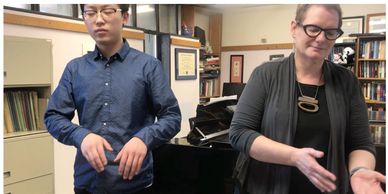PRESENTATIONS AND PEDAGOGICAL WORKSHOPS
THE SELF-COMPASSIONATE MUSICIAN: Strategies for Promoting Well-Being in Difficult Times
THE SELF-COMPASSIONATE MUSICIAN: Strategies for Promoting Well-Being in Difficult Times
THE SELF-COMPASSIONATE MUSICIAN: Strategies for Promoting Well-Being in Difficult Times
This session will explore the impact of self-compassion on music learning and overall well-being. Through reflective journaling, meditation exercises, and interactive processes, we will discover authentic and concrete ways to be kinder and gentler with ourselves, helping us navigate times of uncertainty and stress with greater equanimity.
ALL HANDS ON KEYS: Strategies for Teaching Students with Small Handspans
THE SELF-COMPASSIONATE MUSICIAN: Strategies for Promoting Well-Being in Difficult Times
THE SELF-COMPASSIONATE MUSICIAN: Strategies for Promoting Well-Being in Difficult Times

The hands of great pianists come in all shapes and sizes. Spending literally thousands of hours at the piano, we develop time-tested, proven strategies for learning repertoire in a way that suits our unique physiology. We know best that which we have experienced within our own bodies. How does this impact our ability to work with students with different hand sizes than our own?
Using videos performed on a Steinbuhler DS Standard 5.5™ (“7/8”) piano keyboard and demonstrations on a conventional-sized piano keyboard, this workshop will investigate effective strategies for teaching students with small handspans and ways to exploit musical and technical choices that maximize artistry and biomechanical ease.
FEELING THE SOUND: A Guide to Multi-Sensory, Whole-Brain Practicing
THE SELF-COMPASSIONATE MUSICIAN: Strategies for Promoting Well-Being in Difficult Times
FEELING THE SOUND: A Guide to Multi-Sensory, Whole-Brain Practicing

This presentation will investigate how multi-sensory learning and use of whole-brain processes may enhance our practicing and teaching, leading us to a more artistic, authentic experience. Drawing from a plethora of resources, we will discover ways to use imagery, metaphor, fantasy, intuition, imagination and instinct to “draw from the right side of the brain” during our practicing and brainstorming sessions with students. We will also explore how going beyond the five senses and using multi-sensory ways of knowing can help us tap into what Kandinsky refers to as “the spiritual in art.”
AWAKENING RHYTHMIC INTUITION AND FLOW IN THE DEVELOPING PIANIST
THE ART OF LISTENING WITH DEPTH, UNDERSTANDING, FLOW AND IMAGERY (with Dr. Midori Koga)
FEELING THE SOUND: A Guide to Multi-Sensory, Whole-Brain Practicing

One of the most distinctive, recognizable features of consummate musical artistry is imaginative pacing and rhythmic flow. Yet, playing with a sense of the larger musical beat is not reserved for artists…or even advanced and gifted students. Students at any level can learn to recognize and respond to musical phrasing at the micro- and macro-levels and thereby achieve a more convincing, and musical performance.
ARTISTIC PEDALING TECHNIQUES FOR THE PRE-COLLEGE PIANIST
THE ART OF LISTENING WITH DEPTH, UNDERSTANDING, FLOW AND IMAGERY (with Dr. Midori Koga)
THE ART OF LISTENING WITH DEPTH, UNDERSTANDING, FLOW AND IMAGERY (with Dr. Midori Koga)

Artistic pedaling is one of the most deeply personal and defining features of beautiful piano playing. And yet, it is often one of the most neglected aspects of piano study. While extremely talented students may learn to imitate recordings and teacher demonstrations, synthesizing the impact of stylistic characteristics and coloristic pedaling devices on creating a convincing performance, most students need sequential, guided exercises and opportunities in order to develop comprehensive pedal techniques. This presentation will focus on ways to develop stylistic pedaling techniques at the intermediate and early advanced levels of piano study, including use of legato pedaling, direct pedaling, half pedaling and flutter pedaling.
THE ART OF LISTENING WITH DEPTH, UNDERSTANDING, FLOW AND IMAGERY (with Dr. Midori Koga)
THE ART OF LISTENING WITH DEPTH, UNDERSTANDING, FLOW AND IMAGERY (with Dr. Midori Koga)
THE ART OF LISTENING WITH DEPTH, UNDERSTANDING, FLOW AND IMAGERY (with Dr. Midori Koga)

Artistic playing revolves around the ability to listen between the notes as the music unfolds. When students are truly listening, they have the ultimate tool with which they may begin to make artistic choices for themselves. Finding creative ways to explore the composite sound, to attend to the continual nature of music via singing and movement, and to develop an aural image all serve to strengthen a student’s ability to really listen to the sounds they are creating. This article will explore how to nurture and develop this awareness of sound from the very first lesson.
HEALTHY HABITS AND OPTIMAL BIOMECHANICS FOR THE DEVELOPING PIANIST
BENEATH THE ICEBERG: What we have learned from our Breakdowns and Breakthroughs-with Dr. Midori Koga
THE SELF-COMPASSIONATE MUSICIAN: Learning to Love Your Self Through Music-Making and Teaching

This session explores healthy principles of technique for the developing pianist. Beginning with an overview of optimal biomechanics, we will examine how to cultivate alignment, balance and a basic understanding of how the body works in coordinated piano playing. Drawing from examples from the elementary, intermediate and advanced repertoire, we will investigate common pitfalls and healthful solutions for the developing pianist.
THE SELF-COMPASSIONATE MUSICIAN: Learning to Love Your Self Through Music-Making and Teaching
BENEATH THE ICEBERG: What we have learned from our Breakdowns and Breakthroughs-with Dr. Midori Koga
THE SELF-COMPASSIONATE MUSICIAN: Learning to Love Your Self Through Music-Making and Teaching

This session will explore ways that we can engage in acts of self-compassion in our practicing, teaching and music-making, promoting healing and allowing us to respond with real curiosity. By noticing when we are self-critical, trying to “soften” the critical voice with compassion and without judgment, as well as reframing the dialogue in a gentler, more positive way, we can observe compassionately our thoughts and emotions, without accepting them as factual. This can lead to greater balance, clarity and equanimity. Self-compassion helps us to embrace our humanness, our sense of connectedness, and helps us to see ourselves more clearly. As musicians and teachers, practicing self-compassion can help us to welcome change and nurture the process of growth at the heart of all meaningful artistic endeavors.
BENEATH THE ICEBERG: What we have learned from our Breakdowns and Breakthroughs-with Dr. Midori Koga
BENEATH THE ICEBERG: What we have learned from our Breakdowns and Breakthroughs-with Dr. Midori Koga
BENEATH THE ICEBERG: What we have learned from our Breakdowns and Breakthroughs-with Dr. Midori Koga

In this session, we will share our stories about breakdowns, struggles and failures that have led to our breakthroughs and transformation as artists, teachers, and human beings. Learning to dance with our pain, fears, and self-doubt, we have emerged with a deeper sense of who we are and what really matters. Rather than swimming in a sea of perfectionism that blocks us from the richest parts of ourselves, we have embraced taking risks and failure as essential parts of the creative process. By learning to show up with vulnerability and courage, owning who we really are instead of who we are supposed to be, we have uncovered our spots, claiming them as a central part of who we are. And, by revealing them to others, we have deepened our connections with our students, colleagues, friends, family, and audiences.
Claiming our personal narratives, social identities, and experiences shapes our relationships with our students, our audiences, our music. In this session, we will share stories of breakdowns, struggles and failures that lead to creative transformation.
Copyright © 2024 Jess Johnson, piano - All Rights Reserved.
Powered by GoDaddy

This website uses cookies.
We use cookies to analyze website traffic and optimize your website experience. By accepting our use of cookies, your data will be aggregated with all other user data.